#xenozoology
Text

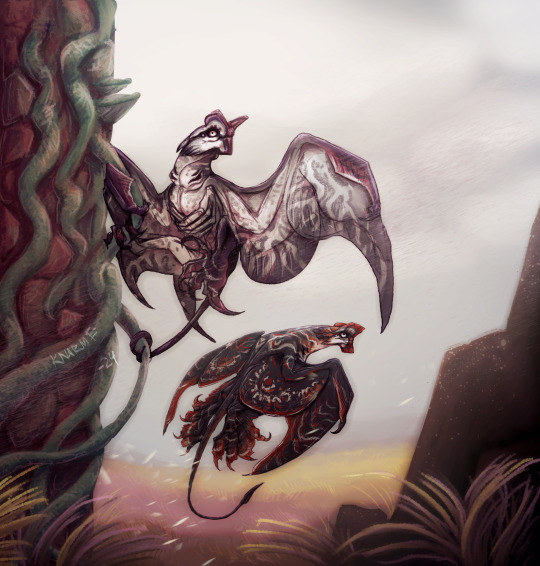
Distant cousins of the jungle's stingbat, the aptly named stunbat (Tsealìm in Na'vi) is a native of the Txepìva volcanic plains that hunts by diving from great heights and colliding with their prey head-first, stunning them.
Their head is blunt, with a threefold crest reminiscent of the great leonopterix's dual one, but significantly more ossified. Their neck is thick and muscular, to help support the structure, but also to weather the high velocity impacts.
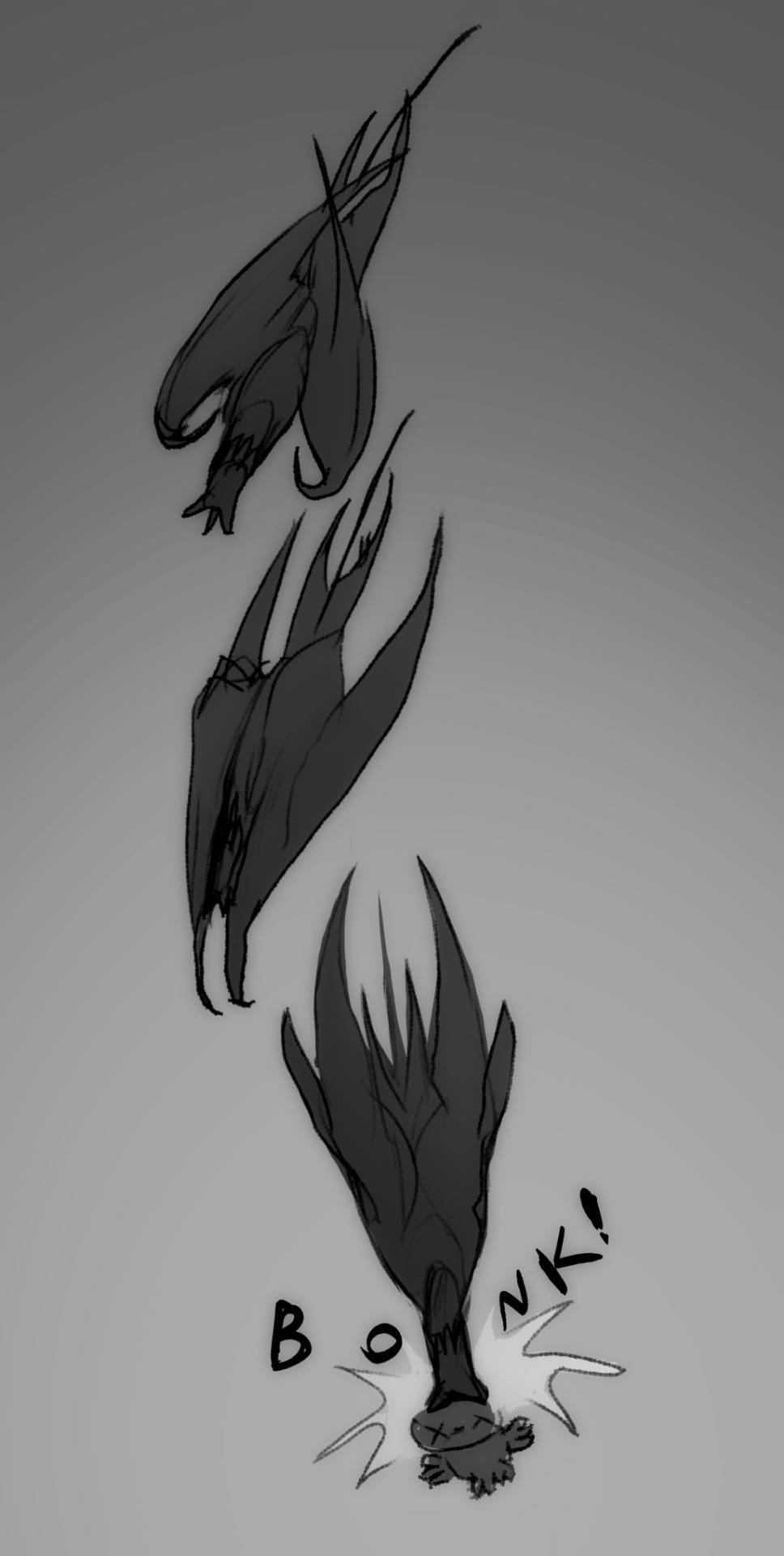

The hands, small and with fused fingers in jungle stingbats, are much larger here, and used to catch stunned prey falling from the sky, or pick them off the ground as they swoop down. It also allows stunbats to eat on the fly, as it were, as the plains' chaotic environment doesn't always provide them with safe perching opportunities.
Stunbats have short, prehensile neural queues that retract under thick, keratinous neck frills. The extra mobility of this limb allows them to make quick connections while in mid-air, front to back, back to back, or belly to belly, the latter being the more commonly seen one, accompanied by a stabilising "handshake".

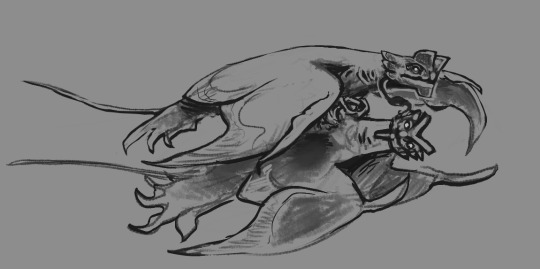
The stunbat's vision is excellent. Early research by Eyris Makri with the Tuin clan of the Txepìva showed that their domesticated stunbats were able to spot prey up to 4 miles away, seeing clearly at ten times the distance of their Na'vi handlers. Their primary eyes show a high concentration of foveas, giving them enough focus to clearly distinguish prey moving against the complex backdrop of the plains and lava fields.
Although the stunbat's barbed tail has lost most of its poisonous sting, it is still used in defence against larger predators. Their best defence, however, remains a Na'vi bow.
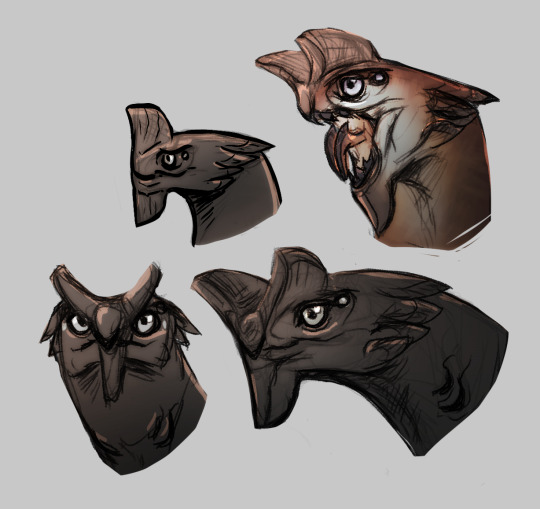
It is hard to tell exactly when domestication started, though the olo'eyktan of the Tau'un clan claims one of his ancestors was the first to tame a stunbat. We're told this happened during the "Time of Long Nights", but dating that event is equally complicated. Current estimations are a minimum of two millenia.
During that time, the stunbat's range remained tied to the volcanic plains of the Txepìva clans, although the species has been observed by Serafiina Hukkala as far out as Mons St. Helen. One must note that the stunbat is unlike our previous study case of the Viperhound, which are bred for various purposes. Interviews with Txepìva hunters (Makri et al.) suggest that their relationship to the Na'vi is similar to that of cats and humans, with multiple domestication events, beneficial to both species. Na'vi led breeding appears to be very incidental, as stunbats tend to fly off to find mates in the wild, rather than mating among their clan's flock.

This species is significantly larger than their forest cousins.
The most common uses of stunbats are for scouting and hunting. While hunting of small game is extremely similar to what humans once achieved with eagles, stunbats also take part in hunting expeditions for large prey.
They are used to follow the movements of herds, but also to help separate young calves from their mothers, or the weak and wounded, by dive bombing them (Hukkala et al.) They understand complex orders, communicate with clicks and shrieks, and will come to hang on the queue or harness of their paired Txepìva to share more detailed visuals through Tsaheylu.
This is also how they are used for scouting. Serafiina Hukkala postulated that the stunbats' mated pair lifestyle influenced Txepìva culture by making the act of scouting a couple's task. Scouting, we must remind the reader, is a lot more crucial to the Txepìva, who have no qualms waging war against each other for the domination of water sources and fertile land. Raiding parties, while not frequent, are a banal part of life on the plains. Even small children learning to work with stunbats will be sent on sentry duties, often on the back of a Lenonin Hound.
The reason mated pairs of stunbats are favoured is because of their long flight range and their ability to connect together in mid-air. This means one side of the couple can move far ahead, and report back to their partner, already extended to the edge of their range. A couple of scouting stunbats effectively covers double the range a single hunter would.
Stunbats are occasionally used to communicate with similar techniques. While one half of a pair can be sent to deliver a message to another tribe, the other remains with their clan (often brooding). The homing individual (whichever has best endurance, as both sexes feed and brood chicks at will) can find its way back to them even if the clan is on the move. More research is needed on their communication capabilities.
When travelling or staying in temporary camps, stunbats are housed in loose baskets designed to let them hang onto the side. These carriers are custom made by every clan and come in many forms and sizes. Brooding stunbats are carried, either by a Na'vi who will fashion straps to turn the basket into a backpack, or tied to the back of Leonin Hounds.
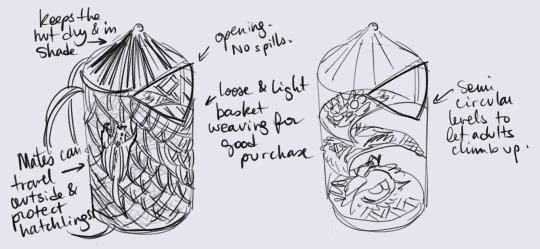
In more permanent camps, the Texpiva craft treillis to give them places to hang from. Serafiina Hukkala reported a clan that arranged dried branches and material for firewood as perches, while Eyris Makri stayed with a couple who fashioned fake branches at the top of their tents, like rafters. Both heard reports of clans that house their stunbats along with their livestock, but the practice seemed frowned upon.
The bond between Na'vi and Tsealìm needs further study. It isn't as exclusive as with an ikran, but much more complex than with direhorses. Stunbats bond strongly with a small family node, and more weakly with the extended family and friend group. Tsaheylu is typically only done with their main Na'vi hunters, although the stunbat can be introduced and passed down to children.
Emergency tsaheylu was witnessed twice by Makri, when a scout had urgent reports and the stunbat was sent ahead. Connection was made with the clan's tsahìk, who had a habit of bonding with every newborn stunbat. The practice, we were told, can be controversial.

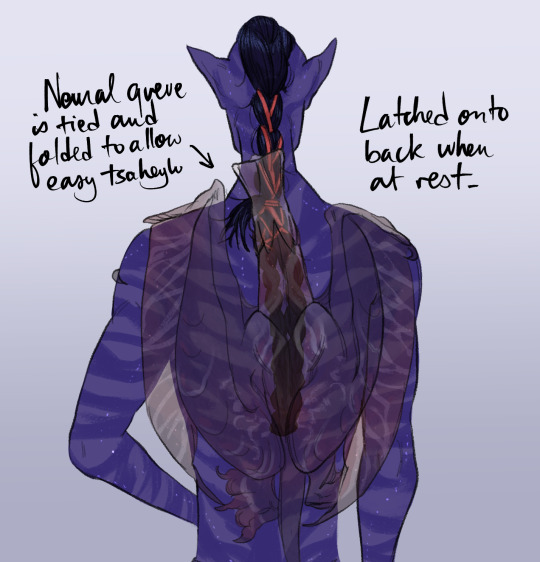
Hunter depicted without ornaments, to highlight the process of Tsaheylu.
Some clans craft harnesses for hunters to better carry and support their stunbats, while others prefer natural body-to-body contact. The folding or tying of the neural queue to allow for better access to the kuru/tendrils seems universal among all interviewed hunters and scouts. Different styles were observed and will be presented in our published notebooks, after our paper on the use of stunbats in skirmishes and outright warfare, as the Txepìva practice it.
Part II of @straydaddy (art and design) and @bluedaddysgirl (lore concept + final art entry) in-world collaborative study, "Introduction to the Txepiva clans, their nomadic pastoralism and niche selective breeding practices in species of stingbats and viperwolves".
On twitter we are Knarme and Bluedaddysgirl
#avatar#atwow#avatar 2#jc avatar#avatar fan lore#fanart#aliens#alien biology#xenobiology#xenozoology#speculative evolution#creature design#concept art#creature art#creature concept#alien concept#fan art#collaboration#alien design#alien creature#spec evo#spec bio#speculative zoology#speculative biology#na'vi#na'vi oc#pandora#stunbat#stingbat#tsealim
81 notes
·
View notes
Text
Le-matya kittens

#I like these predators#star trek fanart#Star trek#Vulcan#Le-matya#Xenozoology#Spock#Star trek tas#Star trek tos#The original series#Feline#Kittens#Cat#Science-fiction
272 notes
·
View notes
Text
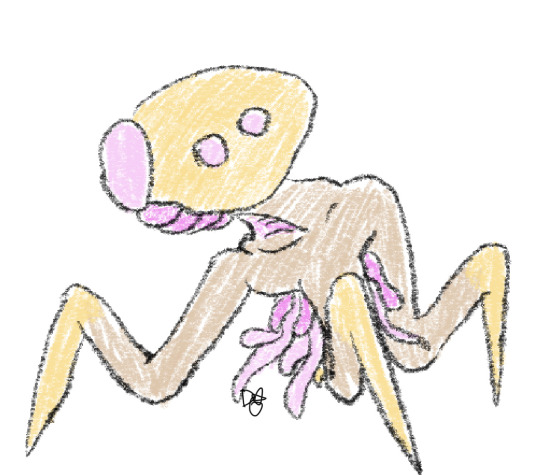
Another creature. No idea what it does, aside from eat with its tentacles.
#art#cartoon#dollé#orginal character#alien#oc#cartoons#reference#creature#character#xenozoology#pink#beige#yellow
0 notes
Text
If you haven't guessed by now Yes moonstone is half me going Omg there's so much New MC content they would have theoretically missed, including the Entire Ocean getting revamped,
And half subnautica
#holds up my subnautica hyperfixation like a trophy!#i couldnt make it through school to do actual zoology so now i do intensive and wild speculative xenozoology on the internet :)
3 notes
·
View notes
Text

attack for lebenkopf on art fight, featuring his character egianna (right) and my character goldenrod (left)! both of them are spore captains interested in xenozoology, so i drew them talking about Critters :]
43 notes
·
View notes
Text
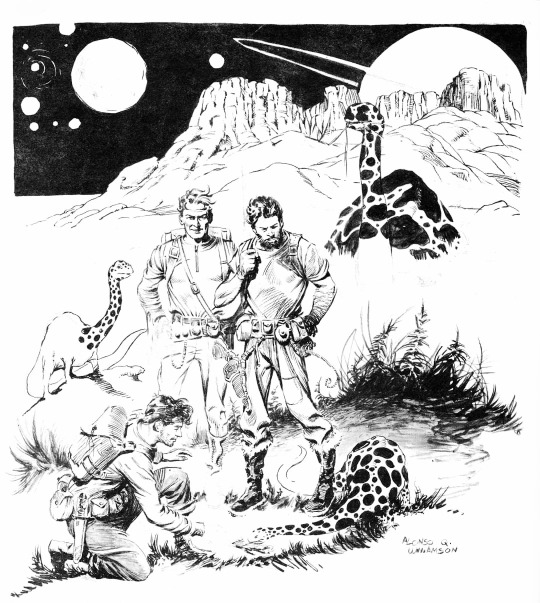
Xenozoology by Al Williamson
40 notes
·
View notes
Text
Fluffy February Day 16: Spontaneous
I realized that I haven't written any baby!twins fluff in ages, so need to fix that lol.
SWTOR
Pairing: The Twins (Aka Setra Rowan and Kevra Kallig, AKA Barsen'thor and Darth Nox)
Time Period: Roughly 12 years before the start of SWTOR, when the twins are about 10. Two years before The Incident.
Location: Coruscant
~~~~~~~~~~~~~~~~~~~~~~~~~~~~~~~~~~~~~~~~~~~~~~~~~
The twins trailed behind their creche mates as the tour guide led the Padawans through Coruscant's Museum of Galactic Cultures. It wasn't the tour guide's fault that they were bored; they had snuck into the museum after-hours on three different occasions, and had consumed more information than the child-appropriate tour provided.
The only reason they participated today was to provide a cover story to hide their midnight adventures; they did not want to alert their masters that they routinely snuck out, even if it was legitimately purely to learn.
Kevra looked over at Setra as their tour group stopped outside an exhibit on Coruscant's rebuilding efforts after the Sacking. Setra, as usual, was feigning interest - she'd always been better at regulating and hiding her expressions. Kevra let out a frustrated sigh.
"You know, we could just bounce. Find a different museum to explore. We could totally time it so we're back before they notice we're gone."
Setra responded with some side-eye. "Too risky, better to wait until tonight. Besides, this isn't even the worst museum we've been to, we can suck it up for a few more hours."
"But I'm bored, Sissy. And we could hit up two different museums if we went now and later."
"Or you can practice patience for once."
"Or you could practice spontaneity for once."
"That's not in the Codes."
Kevra pouted at her sister. "They're not going to notice, Sissy. Master Grey forgets we even exist half the time. And what are they going to tell us, that we're wrong for wanting to actually teach ourselves? As far as rule-breaking goes, this is like, bottom of the list."
Kevra smirked as she saw the gears turning in her twin's head; she knew Setra was just as bored as she was. Setra started to chew her lip, and Kevra took the chance to grab her sister's hand and haul them out of the museum, both sisters cloaking themselves in the Force to hide their escape.
After a quiet yet heated debate, they settled on the Coruscant Xenozoology museum and made their way there; Setra wanted insect subjects to practice drawing. Kevra had to hand it to her sister; she'd never seen so many bugs in one place before. She'd never even heard of many of them.
Kevra set an alarm for when they needed to sneak back to their group; Setra was absolutely terrible with keeping track of time. And money. Anything involving numbers, really, caused her sister's eyes to immediately glaze over. Satisfied with her alarms, Kevra followed Setra as they roamed the museum.
While it wasn't Kevra's first choice (being a 10-year-old girlchild who didn't care for bugs in general), but she was able to write down interesting facts to serenade their creche mates with later.
It was just as well that Kevra'd set her alarms; she'd been swept up by her sister's enthusiasm. When her 90-minute alarm went off, she grabbed Setra and the two scuttled back (thankfully, the museums were only a few blocks apart), Setra hiding her personal notebook away under her robes.
Kevra ended up being right; Master Grey and their creche mates hadn't noticed them missing. Kevra's spontaneous decision was successful, and the twins made plans to return that night to continue their buggy journey.
#the twins were always giant nerds lol#zabrak oc#swtor jedi consular#swtor sith inquisitor#fluffy february#never thought I'd be researching what museums exist in the Star Wars universe lol
2 notes
·
View notes
Text
Spectember 17: Hot Nitro, Ammonia-adapted life.
Crone Fish (Myxine celeroccideres) are an accident.
Our organization is not entirely sure how it happened, but the Crone Fish are an invasive species of another planet
A small unnamed planet in the Frontier Regions, it is notable for having liquid oceans and a rain cycle, the problem being the “water” is entirely ammonia based.
Organization Drones have discovered the remains of a Earth-made Truck, raising even further questions, speared on a tor in the middle of the planets smallest ocean.
The cargo manifest reveals its sole delivery was to be: hagfish.
Now one would think that on their entrance to an entirely alien environment the fish would have little time to adapt if not out right die in contact with the water.
Yet, some genetic alteration is clearly evident, as not only did the Hagfish survive, but seem to have thrived and adapted into an entirely new species.
Their ammonia resistant slime has become like a second skin, and through some chemical process or likely alchemical process is able to turn ammonia into the oxygen they require.
They’re also able to consume the local life forms without any sign of discomfort.
Which due to their natural defense being unknown by the main predators of their new habitat allowed the hagfish to enter a position of prominence within the ocean.
While this hints at them being their for an exorbitant amount of time, we will not be able to do an in-depth genetic study until one of our drones brings back a genetic sample.
Crone Fish border great white sharks in size, and are the apex predators of their new homes, countered only by the starkly intelligent pack hunting “sea turtles” that also call the ammonia waters home.
Their mouth have adapted into a beak like construct, the sheering plates able to bunch through flesh, bone and carapace in equal measure, making them more akin to serpentine Dunkleosteus than their immediate ancestors.
What is more curious is that Crone Fish have been seen beaching themselves on the marshy shores of their new home, and thanks to their ammonia-transmuting membrane are able to survive on land for approximately six hours.
So far, no other life has begun the sojourn to land, and this rapid adaption could see them rise to some form of providence on the planet. Only time will tell. -Xenozoological Study of Frontier World-438.
#spectember#speculative evolution#speculative biology#science fiction#alien planet#alien#fantasy creature#Original Work#OC
2 notes
·
View notes
Photo

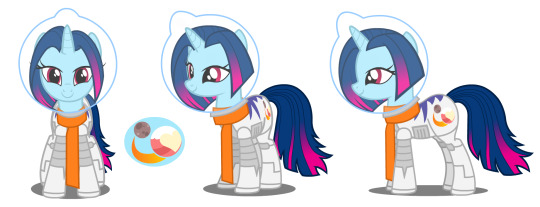

PLUTO PLANITIA:
Born and raised in Equestria, little Pluto got her cutiemark during a class field trip to the outermost planets, where she discovered and photographed a new icy lifeform on Planet Pluto's surface. Since then she has honed her photography and xenozoology skills, as well as having trained herself in raygun self-defense. Her personal magic skill set is sadly limited to Telekinesis, and a few esoteric yet useful spells. On top of that, she is not a purebred unicorn, as the stripes on her back attest to her 1-fourth zebra heritage. She has tried, but potion-making is not her strong suit. She is able to speak in rhyme, although it does not come second-nature to her, and she feels slightly self-conscious about it, afraid she'll mess up.
#Pluto Planitia#Safe#SciFi#FIM Show Style#Show Style Anthro#MLP:FIM#Character sheet#rotational#spacesuit
8 notes
·
View notes
Text
RWBYTREK HCs Part 1
Note: The Timeline’s a mix of NuTrek, STO, and the old Expanded Universe novels.
The USS Beacon-C
Excelsior-class, NCC 201225-C, launched July 18th, 2313 from Utopia Planetia.
Destroyed October 31st, 2387 in [FILE REDACTED]
CO at time of destruction: Cpt. Azerpin Ozm (KIA)
XO at time of destruction: Cmdr. G’Lyn (Reassigned as CO of the USS Pharos)
At time of destruction was essentially serving as a “Talent Scout” ship for promising recruits to replenish the ranks following the Borg War.
The Beacon-C senior staff served as Junior Officers & lower deckers.
Rumored connection to Section 31
The USS Beacon-D
Luna-Class, NCC 201225-D, launched October 3rd, 2388 from Riverside Geosynchronous Fleet Yards.
Fun fact: In the original Titan novels, Luna classes were science oriented vessels more akin to Voyager than flagships like it was presented in Lower Decks. I think, I admittedly haven’t read them in a hot minute
Multi Role forward craft here, not responsible for things like First Contact, but the detection and initial analysis of Warp capable societies in advance of First Contact.
The Crew
Ruby Rose
Human, born in Patch, Indiana to Cpt. Summer Rose and MCPO Xiao Long Taiyang. Raised on the Xiao Long Horse Ranch for most of her life.
Entered Starfleet Academy two years ahead of usual schedule.
Recorded high marks in piloting and mechanics with a specification in Weapons Systems and field command.
MACO scores indicated talent in sharpshooting, tactics, and field tactics.
Passed a Kobayashi Maru adjacent Command Scenario involving a Romulan Warbird, Jem’Hadar warship and Brown Dwarf by waiting until Jem’Hadar ship was in range of Warbird, taking manual weapons control and sniping the Romulan engine, using the resulting destruction to cripple the Jem’Hadar.
Was an Engineering Division student at the time of the simulation.
Recommended to Officer Training and Command Division transfer by Cpt. Azerpin Ozm.
Took command of Beacon-C during [REDACTED] following destruction of the bridge and death or incapacitation of bridge crew.
Has a dog named Zwei & a horse named Crescent. Video game, starship, rock music and old comic book enthusiast.
Still a dork, unsure of her new posting. Still coming up with catchphrase. Liable to nerd out over ship designs. Happy to leave First Contact to the flagships.
Has semi-reserved a Holodeck for “Private captain related activities” (AKA gaming club).
Location since Beacon-C’s destruction: Trauma leave in Patch.
Rank and role upon Beacon-D’s launch: Captain and CO.
Wyss Sh’Cnee
Andorian, test tube baby born to two parents.
Descendant of Nykols Ch’Cnee, a famous Starfleet captain. Her zhi, Wynter Zh’Cnee is currently XO of the USS Atlas, legacy of Nykols’ flagship.
Recommended for Officer Training and Command Division by Commodore James Ironwood, the Atlas’ current CO.
Showed aptitude for sciences, especially xenoarcheology and xenozoology, and a minor in linguistics.
MACO scores indicate specialization in Marksmanship.
Transferred to Science track.
Trained Operatic singer and music fanatic besides that.
Champion fencer, trying to teach Ruby.
Got called Schnee by a German cadet once, Jaune explained it to her.
Location since Beacon-C’s destruction: Reassignment to Lake Ba’ab Environmental Observation Post.
Rank and role upon Beacon-D’s launch: Lt Cmdr and Chief Science Officer.
Mu-yor Svai T’Blake (Alias) Real Name: [REDACTED] (I don’t know if this is a remotely accurate Vulcan name)
Romulan masquerading as Vulcan, due to either surgery or unique physiological similarities to Vulcans. (Ties into HCs I have concerning Vulcan/Romulan species differences)
Snuck into Starfleet under forged record and origin on Vulcan Colony lost during Dominion War. Actual home theorized to be located in the Romulan DMZ.
Rumored connection to known Illyrian pirate and terrorist, Adam Torres.
Recommended for Officer Training and Command Division by Azerpin Ozm.
Specialized in subterfuge, linguistics, leadership, tactical operation and piloting.
MACO scores indicate specialization in stealth, marksmanship, CQB and bladework.
Trained in Qowat Milat martial arts and a master tan qalanq swordswoman.
Investigation was pending at the time of the Beacon’s destruction, disappeared during the confusion.
Subject of interest to Section 31.
Location since Beacon-C’s destruction: Intelligence shows she’s been operating in Romulan Free Space as a member of the Fenris Rangers under the pseudonym “Belladonna”
Rank and role upon Beacon-D’s launch: Cmdr and Comms Officer, unofficially the XO.
Xiao Long Yang
3/4 Human, 1/4 Klingon, has enhanced strength and small head ridges.
Born to Xiao Long Taiyang and Ravn, daughter of Branhwn, former Starfleet Tactical Officer and current known criminal.
Expert in equestrianism and animal husbandry.
Signed up to Starfleet as an enlisted woman, studying at the Starfleet Services Academy on Tellar, including both Engineering school and full MACO coursework, graduating the equivalent of suma cum laude in both subjects.
Served brief tours on the USS Belarus and the USS Signal Fire before transferring to the Beacon-C as a Chief Petty Officer and Transporter Chief.
CQB specialist, and widely recognized as an engineering genius.
Was basically the highest ranking RWBYJNPR member in the crew, was literally almost senior staff member.
Lost an arm shortly before the Beacon-C’s destruction at the hands of Illyrian terrorist Adam Torres. Was absent from the ship as a consequence.
Location since Beacon-C’s destruction: Mechanic at the Patch, Indiana Shuttle Flight Academy.
Rank and role upon Beacon-D’s launch: Senior Chief Petty Officer and the Chief Engineer.
#RWBY#Star Trek#RWBY AU#Star Trek AU#RWBYTREK AU#Team RWBY#Ruby Rose#Weiss Schnee#Blake Belladonna#Yang Xiao Long
13 notes
·
View notes
Text

Selective breeding of viperhounds by the Txepiva clans
The Txepiva clans, also known in some parts as the Ash People, have no ikran and no pa'li. They are long distance runners and hunters, often on the move. Many of them are nomadic pastoralists, a practice unknown among the rest of the known Na'vi.
Their habitat, in turn bleak and burnt or rich and green, rarely forms anything close to a forest. The clans are always on the move, frequently fighting over territory, and yet regularly meeting with others in great gatherings. The largest, meant to reunite all the disparate Txepiva clans, is called the Tsawlultxa, and is the perfect opportunity to discover and study the stunning variety of Nìsayntang.
Just like mankind adopted wolves and turned them into dogs, the Txepiva adopted the plains' viperwolves. Millenia of selective breeding created the Nìsayntang, which the RDA catalogues as viperhounds.
Most neighbouring clans outside the Txepiva look down on breeding, preferring to go in the wild to capture their own mounts. We're left to understand it verges on taboo. As usual, the Txepiva seem to hardly care or take notice of their neighbours' distaste.
The relative isolation of each clan has allowed for the development of several subtypes of Nìsayntang.
Some clans have hounds whose forward arms have evolved to grab prey, while in others it's the secondary pair, with the elongated fingers of the hand coming back to fold over the rib cage in a position reminiscent of the stunbat's secondary arms.
Another clan breeds specifically for hunting in low light visibility.
Here are some examples of breeds of Nìsayntang!
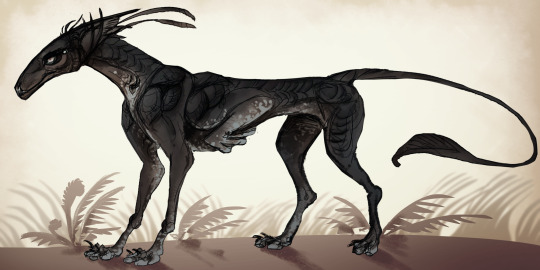
The most standard breed type, seen all across the plateaus and plains. They reach up to a Na'vi's knees or higher, much like a greyhound for humans. They're excellent runners and hunt as a pack, keenly aware of the Na'vi hunters movements. They can carry and manipulate objects with the prehensile limbs that have retracted against their chests. It's most commonly the middle pair of limbs, but as we'll soon see, some clans have bred hounds whose frontal limbs are the ones that evolved to hold and grab.
Nìsayntang are intelligent creatures, keen to help, and capable of understanding complex orders, especially through tsaheylu. This agile breed, quick on its feet, is favoured by the clans that raise srä‘etnaw (the livestock at the source of aforementioned pastoralism).
They'll assist their Na'vi with crafts, carrying things across the camp, leading scouting missions and reporting what they see, or for the best trained one, even hold the meat before it gets grilled! They also use their hands to grab stray srä‘etnaw pups and bring them back into the fold.
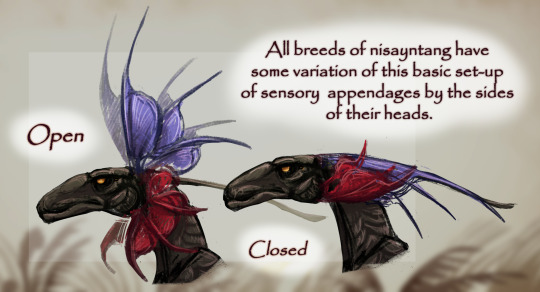
The facial appendages of Nìsayntang are flexible sensory organs. They help them sense their environment, but also play a major role in how they communicate between pack members. Think of the way wolves communicate with their ears, back on Earth.
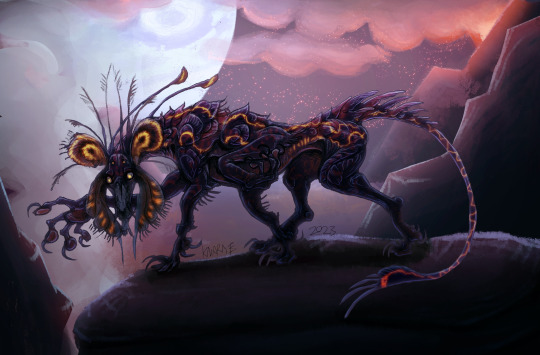
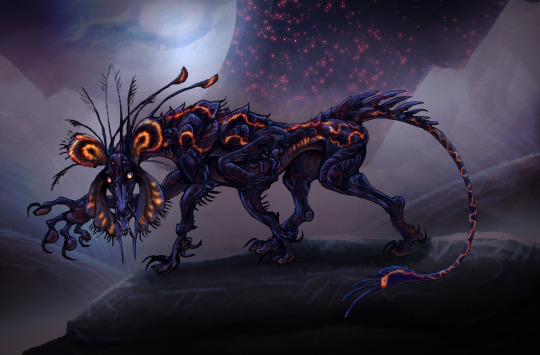
This variation is quite rare, and bred by a single tribe that favours night-time hunting and lives along black volcanic cliffs and lava fields. It's one of the darkest environments known in Pandora, especially during eclipse.
Their Nìsayntang have greater control of their natural bioluminescence, granting them better camouflage. Like a cuttlefish fooling its prey, they can modulate and increase the bioluminosity, creating alluring displays. The sensory strangeness causes their prey to freeze, equally curious and confused, and now vulnerable to ambush.
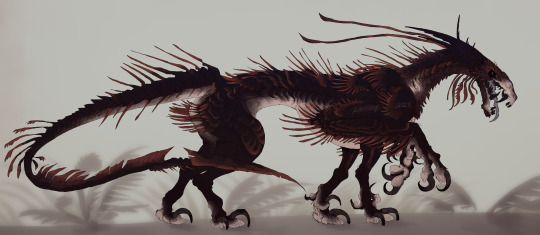
The stem-nisayntang were quite the genetically diverse and chaotic bunch, and the Na'vi of the Ash clans have been practising selective breeding on them for far longer than humans have with dogs.
This is an example of the aforementioned breeds in which it's the foremost limbs that have developed to extend and grab. It's the largest of the breeds presented in this study, as large to a Na'vi as a lion to humans, and aptly nicknamed "Leonin Hound" by first contact researchers. Their huge, heavy arms make them ambush predators, preferring bursts of speed and action to their cousins' long distance running. Their hands aren't as nimble or crafty, each fingers closer to sharp, robust talons.
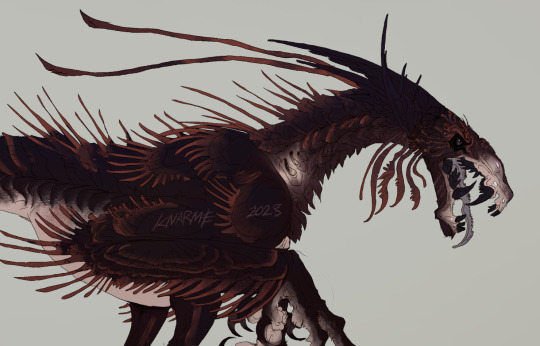
They have serrated teeth that tear through muscle and cartilage with unsettling ease. Their bite can even cut through most of the natural keratinous armour of Pandoran animals.
Their bodies are covered in bristles that help them sense vibrations in the air and ground. Those keen senses and efficient ambush tactics have gained them a reputation as “All-knowing guard hounds” among travellers who’ve met their keepers.
Despite the fearsome appearance and size, their pack mentality, as well as their ability to bond with their entire clan, make them desirable playmates for children, and it's not rare to see a couple of Txepiva youngsters tasked to guard toddlers and younger children, doing so with the help of their hounds. It's also quite common for them to ride on their back. Despite what a human might think of such a sight, it's as safe and natural to the Txepiva as riding an ilu as a child is for the Metkayina.
Bred to fend off the fearsome wildlife of the plains, the Leonin hounds are fiercely efficient at it and seem to have had their sense of fear bred right out of them. As such, they're one of the most widespread breeds in the plains. A handful of clans produce pups, and some are then traded at the great yearly Txepiva gathering. A clan might have their own specialised breed that has been living alongside them for untold generations, and still keep a couple of the Leonin hounds to help safeguard their camps.
Part I of @straydaddy (art and design) and @bluedaddysgirl (lore concept) in-world collaborative study, "Introduction to the Txepiva clans, their nomadic pastoralism and niche selective breeding practices in species of stingbats and viperwolves".
On twitter we are Knarme and Bluedaddysgirl
#avatar#atwow#avatar 2#jc avatar#avatar fan lore#fanart#viperwolf#space doggos#aliens#alien biology#xenobiology#xenozoology#speculative evolution#creature design#concept art#creature art#creature concept#alien concept#fan art#collaboration#alien design#alien creature#spec evo#spec bio#speculative zoology#speculative biology#na'vi#na'vi oc#nisayntang#pandora
157 notes
·
View notes
Photo
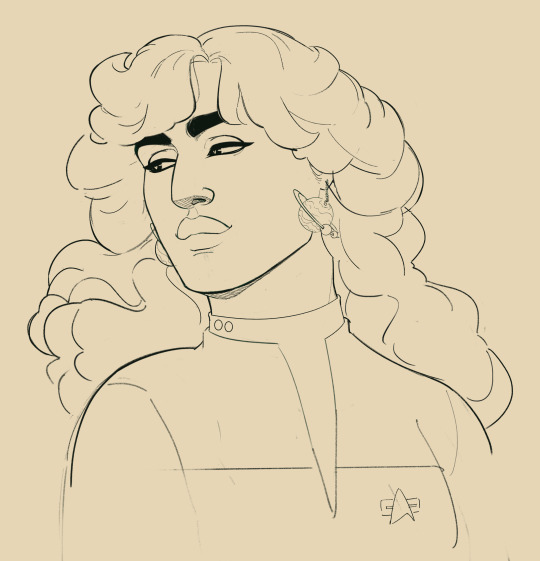

STAR TREK AU TIME
(This takes place during and in the aftermath of the Dominion War)
(Also I started a new blog for Star Trek and sci-fi, @theomegadirective, I might throw up more of these two on there)
Theo's an Orion who joined Starfleet to pursue xenozoology. She feels conflicted about leaving her unstable homeworld, especially considering the apathy--if not outright complicity--Starfleet/the Federation have toward the Orion slave trade and piracy.
Bakri's a Cardassian who hides both his assigned gender at birth and his quarter-Bajoran heritage, the latter of which only shows in his softer ridges and distinctly non-Cardassian curly hair. He took on a male identity and joined the Cardassian Guard early on in life. While he seemed as brutal and dogmatic as they come, he nevertheless broke away from the Guard and fled Cardassia when the Obsidian Order intelligence agency was destroyed in 2371.
The two of them meet when he asks for asylum from the Federation and Starflee. He docks at Deep Space Nine, wounded, with his shuttlecraft moments away from a warp core breach. He stays on the station while Theo’s ship the al-Battani (captained by Nesrin Ciziri) is refitted for war with the Klingons and, later, the Dominion.
#my art#theo#bakri#slavery tw#war tw#an elaborate excuse to give theo farrah fawcett hair#she works for starfleet and wears planet earrings that definitely violate uniform code#she's perfect i love her
8 notes
·
View notes
Text
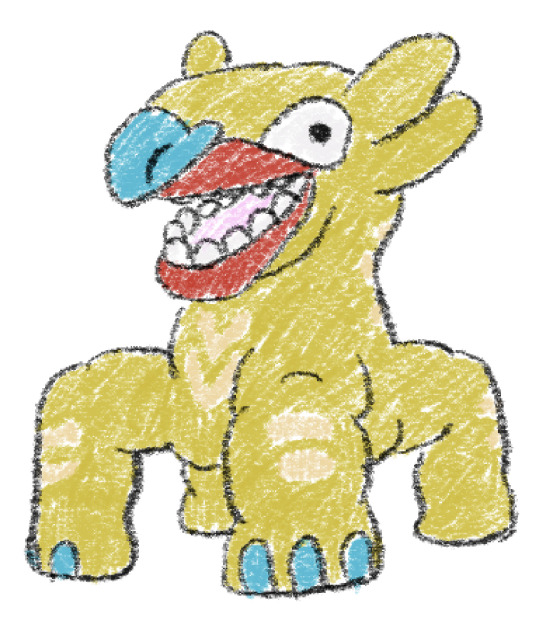
Creature of the day, drew this while waiting for Barbie and Oppenheimer

This guy also was part of the BarbEnheimer excursion.
#art#dollé#cartoon#orginal character#alien#oc#cartoons#reference#creature#creatures#characters#Barbie#openheimer#aliens#xeno#xenozoology
0 notes
Text
i think a very genius aspect of fin fin and its conception is that like. the whole ‘omg hes your best friend!! see see!!!!! he wants to be YOUR FRIEND!!’ does not get grating n old n preachy at all because fin fin is not like. an obnoxious in your face talking animal constantly demanding attention, hes like. very much conceptualized and categorized as a wild animal living in an alien environment that you must approach slowly and cautiously and have respectful interactions with as if you were a researcher documenting life in said alien planet in which he resides which is. so so interesting n makes things feel much more organic n pleasing.
suddenly the ‘hes your best friend’ thing becomes less ‘you will instantly gain a friend who loves you so so much and never leaves you alone’ and more ‘fin fin being your best friend is a reward for your kindness and patience and appreciation to the local fauna and flora, which he is a part of’
he has his own little life! he is an adult of his species and has a companion and offspring, he has favorite spots in which he does not like to be disturbed in and he is scared of loud noises and doesnt necessarily recognize real speech... yknow like a wild animal.
it all gives this vibe of ‘working as an intern on a weird xenozoology trip and ending up making a strong bond with a little alien animal’ which is so so good and wholesome. always and forever, hes your best friend.
#Commander's orders#the fin fin head in me jumped out#i do confess i love the little guy n all things fin fin
7 notes
·
View notes
Text
NPC Spotlight : Mola Haxtor
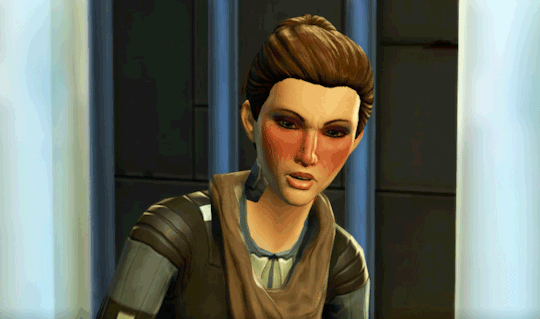
This is Mola Haxtor. She is/was a Republic xenozoologist on Taris, studying the Rakghouls. She a quest-giver on the Republic side.
She was later captured by the Sith Empire when they invaded.
She is not having a good time.
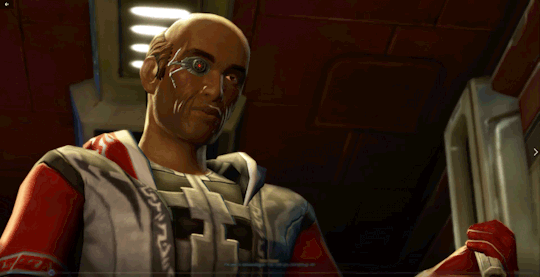

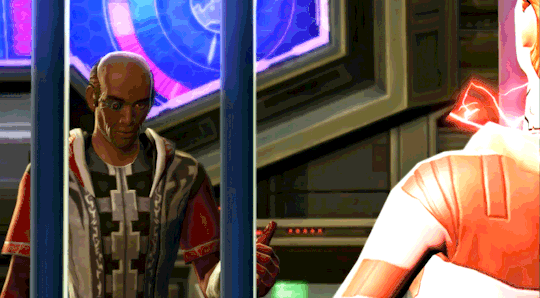


Melkor is mostly torturing her for giggles. She’s not lying or refusing to answer anything.
Still - she does have some spirit left in her.


She also tells us about the nekghouls.

Later, Thana Vesh zaps her just because.... well, its Thana.

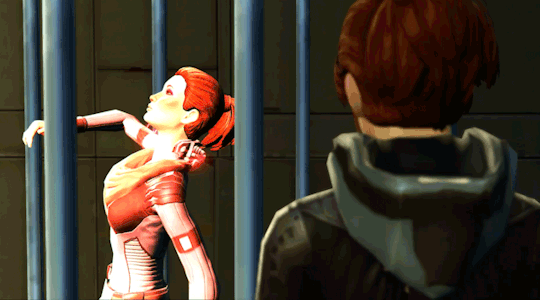
In just two scenes, she makes quite the impact. But she has no dialogue after that.
Mola’s fate is left uncertain.
In my Legacy built around Quoorah Beltane, Quoorah insists she take Mola off Malkor’s hands. She relates to Mola a lot, as she was another intelligent woman tormented by the Sith. (Quoorah had been in medical school before she had been arrested and sent to Korriban.) Afterwards, Quoorah frees Mola, and quietly sets her up on Nar Shaddaa, under the protection of her cult. They remained friends for years.
In my Halcyon Legacy, Mola sadly caught the eye of Lord Kael, the future Emperor’s Wrath. I have a WIP planned about that, but it doesn’t end well.
Still - i wish we’d had some resolution to her story.
#swtor#mola haxtor#taris#thana vesh#melkor dinn#sith empire#rakghouls#oc: Quoraah Beltane#oc: lord kael#oc: kael#npc spotlight#swtor npc spotlight#xenozoology
26 notes
·
View notes
Text




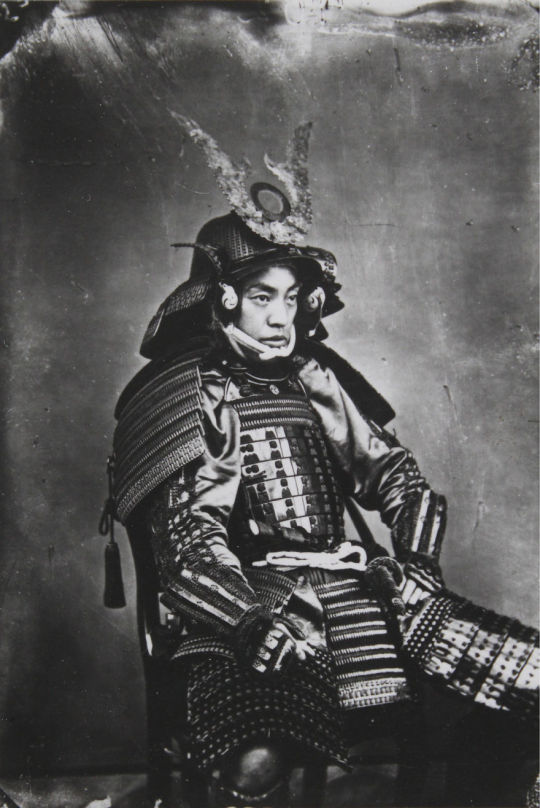



Looking at older cultures for inspiration for what could be out therr, for sentient life we could recognize! A Cat 😺 Race, a world of desert and savannah. world with large seas, Tundras Mountains and grass plains, forest at the equator and the herbivores, are more abundant! A ceremonial race, designed for war, now on their own for 10k years with FTL sub flight, and a love of art and music and theater!
over 30 billion, and 100k systems and 10k species under their expansionary empire.... From the Andromeda Galaxy!
male to female 100,000/1, 7 caste systems
1 note
·
View note